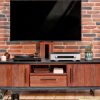While my opinion on really expensive phono cartridges is not going to change, there is some logic spending between $500 and $900 if the table and tonearm have the capabilities to really do the cartridge justice. Spending $3,000 on a cartridge is idiotic — that’s almost 100 new vinyl pressings in 2022. Music over technology should be a bigger priority.
I have only spent over $500 on a phono cartridge three times in 52 years; I paid over $1,000 CDN for a Benz Micro Glider SL in 1999, $750 for a Dynavector 10×5, and $750 USD for the Ortofon 2M Black in 2018.
A very clumsy human being destroyed the Benz Micro Glider and that really made me reconsider expensive cartridges for almost 18 years; the 2M Black on my restored Thorens TD-160 Super/Rega RB-303 is better than I could ask for and the Dynavector has proven to be a great option for the Thorens TD-145 MKII.
The high output of the 2M Black is very useful from a reviewing perspective, because it allows me to judge the MM phono sections of integrated amplifiers with a very high quality cartridge.
If the Goldring Eroica HX Moving Coil Cartridge offers the kind of performance for the money that made me open the wallet for the Goldring E3, this might be a phono cartridge to consider going forward for audiophiles looking for a high output moving coil that really digs out the detail.
The latest member of its moving coil (MC) cartridge family, the Eroica HX, joins the award-winning LX model in the Eroica range (‘Eroica’ translates as ‘Heroic’ in Italian). This high output, high-performance cartridge makes upgrading from a moving magnet cartridge to a moving coil model straightforward.
Goldring doesn’t get the same attention from the audio press as Ortofon, Sumiko, or Grado Labs — but it definitely makes phono cartridges that are just as good, and even better value in some cases.

At $899 USD, the Goldring Eroica HX faces some stiff competition from the Ortofon 2M Black, Hana SL, and Dynavector 10×5 MKII cartridges — but Goldring’s track record made me confident that it would not disappoint.
Is there a growing customer base of vinyl listeners for a $900 phono cartridge as we head into 2023?
Brands such as VPI, Linn, Clearaudio, Rega, and Pro-Ject would argue that they have never had a bigger pool of fish to peddle their wares and that the market for $750 to $1,000 cartridges is booming.
Having spoken to a number of cartridge manufacturers — that’s not entirely true.
90% of cartridge sales are below $400 and that percentage is not shrinking.
The recently released RIAA H1 2022 Recorded Music Revenue Report offered a rather interesting snapshot of where we are in the United States in terms of music consumption, but it was also notable for some trends that can’t be swept under the rug.
Physical music sales only represent 10% of the total market in 2022; streaming is now 84% and while there was not a huge uptick for audiophile platforms like TIDAL, Qobuz, and Deezer — they are not going away anytime soon.
Vinyl sales jumped 22% during the first 6 months of 2022, but there are some takeaways from that modest level of growth as we move into the post-pandemic economy that is hampered by high inflation, and supply chain issues that persist.
The prices for new vinyl releases are becoming a problem for both consumers and retailers.
That doesn’t mean that you shouldn’t consider something like the Eroica HX but it’s leaving consumers with less money in their pockets for better cartridges and phono preamplifiers.

Technology
- New, pure-iron cross-armature design for correct impendence matching
- Ultra-fine, enamelled-copper windings for higher output and low crosstalk
- Equipped with Gyger II diamond stylus that can trace frequencies as high as 50kHz without distortion
- Housing made from lightweight Pocan® composite material, chosen for its anti-coloration properties
Specifications
- Frequency Response 20 Hz – 20 kHz ± 3 dB
- Frequency Range 10 Hz – 50 kHz
- Channel Balance within 1 dB @ 1 kHz
- Channel Separation better than 25 dB @ 1 kHz
- Sensitivity 2.5 mV ± 1 dB, 1 kHz @ 5 cm/sec
- Static Compliance 25 mm/N
- Trackability 85 um (@ 315 Hz)
- Equivalent tip mass 0.4 mg
- Vertical Tracking Angle 22 °
- Stylus Radius Gyger II
- Stylus Type Non-Replaceable (re-tip service available see website)
- Load Resistance 47 kΩ
- Load Capacitance 100 – 500 pF
- Internal Inductance 0.13 mH
- Internal Resistance 35 Ω
- Cartridge Mass 5.2 g
- Cartridge Mass (inc. fixings) 6.6 g
- Fixing Centre 0.5 ” (12.7 mm)
- Playing Weight 1.5 – 2.0 g (1.75 g nom.)
The Eroica HX manages to combine performance and rather easy installation thanks to Goldring’s engineering know-how. By using numerous ultra-fine enamelled-copper windings – so fine they literally float – the Eroica HX has output sufficient to work with moving magnet phono inputs without compromising the low crosstalk that moving coil designs are renown for.
We’ll discuss how well that works when we discuss its performance with both external phono preamplifiers and the MM section on a number of integrated amplifiers.

System
The Eroica HX is a rather slim and lightweight cartridge and I spent time listening to it on 2 of my restored vintage turntables because it was not a great match with the tonearms on my NAD C 588 and the Pro-Ject Debut Pro.
My aforementioned Thorens TD-160 Super utilizes a Rega tonearm and has proven to be a great match with the Ortofon 2M Black over the years; very easy to mount, very quiet in the grooves, and an excellent tracker.
My Yamaha YP-701 has a custom Ortofon headshell that I use with the Grado Timbre Opus3 and that has also proven to be a reliable and quiet combination.
The Eroica HX worked best on the Rega tonearm and there it remained for almost 3 weeks.
Phono preamplifiers included the Croft RIAA Phono, Moon by Sim Audio LP110 V2, Pro-Ject Tube Box DS2, and the Andover Audio SpinStage.
Because of the high output, we also ran the cartridge through the MM section in the NAD C 316BEE V2, Schiit Ragnarok 2, and Cambridge Audio AXA35 Integrated Amplifiers.

Sound
The 2.5mV output matches the Dynavector but that’s where the similarities end; the 10×5 is warmer and rounded off at both extremes whilst the Eroica HX is energetic and transparent from top to bottom.
Clarity?
I hate the “like looking through an open window” example because it’s totally untrue — but the Eroica HX does come close.
The Eroica HX does offer a very transparent sounding presentation that is rich with detail, but it’s also not the most colorful reproduction of what is in the grooves — your final result with definitely be influenced by the phono stage and the system on the other end.
The Pro-Ject was the best match tonally and it didn’t strip away too much of that clarity in the process. The Croft (RIP Glenn) did well to accentuate the Eroica HX’s strong sense of pace and detail, but I really only enjoyed the combination with warmer sounding electronics and loudspeakers.
The neutral sounding LP110 V2 was a better match for the Dynavector, Grado, and Ortofon cartridges.
Dexter Gordon’s One Flight Up (Blue Note Tone Poet Series) and Andrew Hill’s Passing Ships (Blue Note Tone Poet Series) are rich with so much tone and color and felt like strong tests for the Eroica HX; the cartridge is a strong tracker and was always very quiet in the grooves.
Gordon’s tenor saxophone was extremely vivid and sharply drawn in-between my Magnepan LRS but it lacked the vibrant color of the Grado and Dynavector cartridges when used with anything but the aforementioned Pro-Ject phono preamplifier.
The Dynavector trades some detail and clarity for that added midrange warmth and there were a few passages where it was clear that the Eroica HX illuminates the music differently.
Vocals are pushed slightly forward with the Goldring and I found it to be rather similar to the 2M Black in that regard; the Danish cartridge does add slightly more color in the midrange and the bottom end has greater solidity.
Listening to Stravinsky, Dvorak, and Khachaturian, I loved how the Eroica HX breathed some light into some dark sounding recordings and gave strings some needed energy; detail was excellent but I did long for slightly more resolution.
Running the Eroica HX through all of the integrated amplifiers produced very similar results based on the tonal balance and presentation of the amplification; warmer sounding amplifiers produced better results.
I was quite surprised that the NAD C 316BEE V2 didn’t work as well as it had with the less expensive Goldring E3, but it’s very likely that the internal phono stage doesn’t have the capability to show off the resolution, detail, and clarity of the cartridge that is almost $450 more expensive than the amplifier itself.
The best combination was the Pro-Ject Tube Box DS2 through my Cambridge Audio Edge A which runs almost $7,500 for the components alone.
Powerful, transparent, detailed, and highly engaging with most recordings — which is the type of performance that I would have demanded for $900.
Using 7 different phono sections also demonstrated that the Eroica HX requires 45dB of more of gain.

Conclusion
The Goldring Eroica HX is a fuss-free, detailed, and transparent sounding cartridge that requires rather careful system matching to deliver satisfying long-term results.
Installation is not overly complicated and it proved to be a very strong and reliable tracker with even really dirty records.
The neutral tonal balance might be appealing to some, but I found that it performed best with warmer sounding phono sections and amplification that infused it with some necessary color.
The $900 asking price is on the higher side in comparison to less expensive options from Ortofon and Dynavector but it’s very difficult to go wrong with any of them as long you match them up appropriately.
Where to buy: $899 at Goldring USA


































James H
January 2, 2023 at 2:35 am
I still use my audio Technica AT962xe from the 80’s and it works for me just fine.
Bert Oling
January 27, 2023 at 8:28 pm
Also a professional reviewer I considered the internal resistance. 35Ohm a beauty. So why use a undamped 47kOhm termination?…..I used the Eroica HX with my Elac Alchemy PPA-2 with a termination of only 700 Ohm…..It was a revelation….
Ian White
January 28, 2023 at 12:24 pm
Bert,
I have the Pro-Ject Tube Box DS2 and the Moon by SimAudio LP110 V2 here right now and I’m planning on an update to the article in early February. Great suggestion.
Best,
Ian White